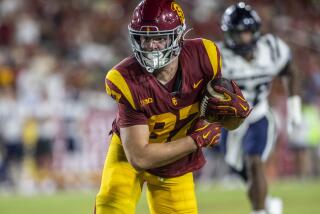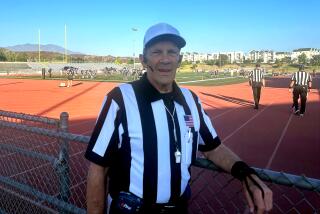CROSSING THE LINE : Tight End Lee Brannon Provides San Diego State’s Struggling Defense With an Extra Lift
SAN DIEGO — On most football teams, you are what you wear. At San Diego State, offensive players wear white jerseys in practice; defensive players wear black.
Lee Brannon wears both.
In these days of nickel backs, pass-rush specialists, running backs who only run, running backs who only block, kickers who only kick off, kickers who only kick field goals and players who only picket, that makes Brannon kind of special.
Brannon, a junior transfer from Contra Costa College in San Pablo, near Oakland, began the season as a reserve tight end used primarily in blocking situations. But with the Aztecs’ defense struggling, Coach Denny Stolz decided to try Brannon at defensive end.
“The offense realized we needed some help,” said Dan Underwood, the defensive end coach. “Brannon had come in late; he was a little bit behind offensively. They said, ‘How about you try him on defense?’ ”
The experiment began last week, and the early results are more than encouraging. Brannon may be the brightest spot on what has been the bleakest of starts for the SDSU defense. He made his defensive debut in a 49-7 loss at Air Force in a Western Athletic Conference game Saturday. He was on the field for only 15 defensive plays but was in on six tackles. He might even start at defensive end when the Aztecs play at Oregon Saturday. Brannon estimated he was in for 12 plays on offense, mainly in a blocking role. He does not have a reception this year.
“He was in for only a short time, but he graded out higher than anybody else on the team,” Underwood said. “He is one of those kids who goes all out. He’s got a great temperament, a nose for the ball and a great burst (of speed) for a defensive lineman. He covers a lot of ground in a short period of time. That’s what you need in a pass rush.”
Said Stolz: “We’re going to really need him down the line. In this conference, you’ve got to have a pass rush.”
In one week, Brannon has gone from trying to protect the quarterback to trying to sack him, and back again. He played both ways against the Air Force, although he first took the field as a defensive end.
“I saw some surprised looks on some of their faces when I lined up over on their side of the field,” Brannon said. “They must have thought we were getting ready to do some kind of trick play. Some of their guys came up to me afterward asking me what in the world I was doing.”
Probably trying to catch his breath. Without the normal rest periods, the physical and mental demands of playing two ways are great enough without having to do it in the 6,500-foot altitude at Falcon Stadium.
Brannon said he slept during the entire two-hour flight home on the plane and was so tired that after the team arrived in San Diego Saturday night, he immediately went to bed and slept another 13 hours.
“Rest, rest, rest,” Brannon said. “That’s all I did. Rest. You need it. I’m telling you, after something like that, you just rest.
“I really felt like I played a football game. It was like when in high school and you go both ways, after the game you’re dog tired. That’s how I felt.”
Brannon is not complaining. He seems to enjoy his new double role. He splits his practice time between the offensive and defensive units, sometimes sprinting between the two sides of the field.
Stolz said the coaching staff has worked to be fair, trying to balance the needs of both the offense and defense with the physical demands required of Brannon. When a team has a 6-foot 4-inch, 235-pound player as fast and as physically gifted as Brannon, everybody wants to find a place for him. After his performance against Air Force, it appears that the defense might be winning. Brannon swapped his white practice jersey for a black one Tuesday, a sign that he figures to spend quite a bit of time on defense against Oregon.
“We finally got a black jersey on him,” Underwood said. “We think we’ve got him for the most part this week, but the offense can pull him back anytime they need. Denny calls those shots.”
That Brannon also has ended up playing defense should come as no surprise. The Aztecs are ranked next to last in three categories--yards allowed per game, rushing yards per game and points allowed per game--among the 104 National Collegiate Athletic Assn. Division I-A teams.
Brannon had not played organized football until his freshman year of high school in El Cerrito, near Oakland. A physical education teacher all but tricked him into the sport.
“I was a big kid and the teacher was always trying to get me to play football, but I didn’t want to,” Brannon said. “So one day he assigned me a detention. Usually you get a detention for doing something bad. I hadn’t done anything, but he told me to come anyway. He met me in the gym after school. He took me out on the field, gave me a helmet and some pads. I practiced, and I liked it. I’ve been with it ever since.”
Brannon played offensive and defensive tackle his junior and senior years at El Cerrito. A poor student who did not qualify to play major-college football after high school, Brannon said he almost gave up the sport to attend a trade school.
“I didn’t pay attention to school work,” Brannon said. “It didn’t hit me until the end of my junior year. Then it was too late.”
But Contra Costa Coach Tom Kinnard persuaded Brannon to give football and school another try. At Contra Costa, he played offensive tackle as a freshman and tight end as a sophomore. He caught only 15 passes last season, and many colleges did not recruit him because he still needed to finish requirements for an associate’s degree before he would be eligible for major college athletics.
The academic requirements kept Brannon from practicing with the Aztecs until the start of preseason camp Aug. 9. He was set further back when he separated his right shoulder in a non-contact drill. He still must wear a harness that restricts his ability to reach for passes. He does not have a reception in the Aztecs’ first three games.
“It was a freak accident,” Brannon said. “My arm was going back and I swung so hard, I popped it out.”
Little of this comes as a surprise to Kinnard. Brannon was his most talented and hardest-working player.
“He only knows how to go one way and that’s all out, even in practice,” Kinnard said. “Some guys know how to pace themselves in practice but not Lee. The kid has great given talent. The only surprise in all of this is that a Division I school would have a kid go both ways.”
The situation has taught Brannon about the need for team unity and the divisions that can spring up in a team that has a 1-2 start.
“I had to adjust to the idea of a team,” Brannon said. “I used to think offense, just offense. But after playing defense, too, I realize it’s not just offense. It’s offense and defense. I’ve got the team concept now. Some guys are going, ‘The defense didn’t do this or the defense didn’t do that.’ Now I say, ‘Hey fellas, we’re trying. I’m going hard every play.’ I never got the picture of that before.
More to Read
Go beyond the scoreboard
Get the latest on L.A.'s teams in the daily Sports Report newsletter.
You may occasionally receive promotional content from the Los Angeles Times.










